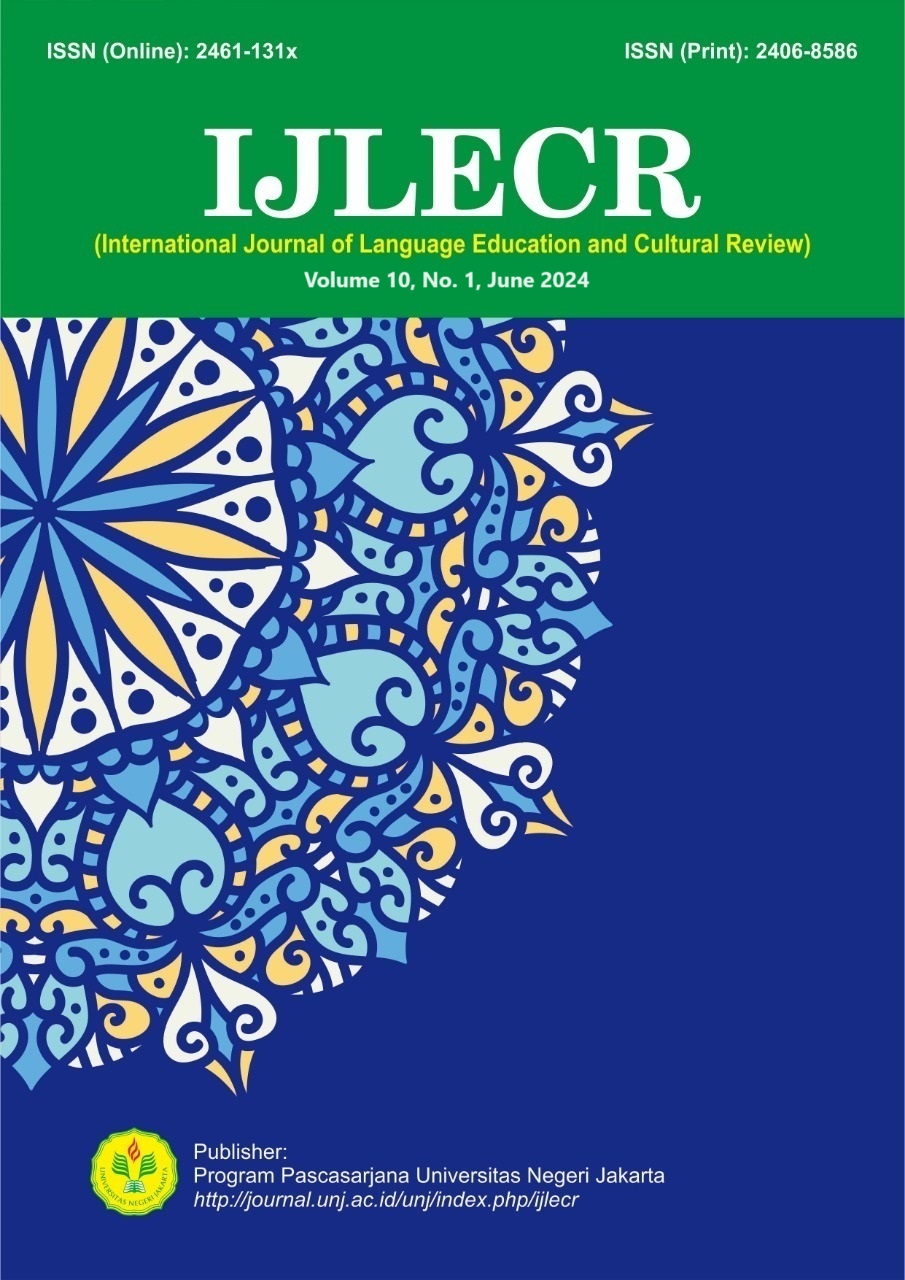A Fun Autodidactic Learning Model for Students to Improve Second Language Understanding
DOI:
https://doi.org/10.21009/ijlecr.v10i1.39523Keywords:
Learning Models, Difficulty and Improvement, Second Language AbilityAbstract
Learning a second language, for example, English is often considered difficult by most students. In fact, this foreign language is very important for them in further studies and the world of work. Therefore, this research aims to determine a fun autodidactic learning model for students to improve second language understanding Apart from that, the writer also wants to know what methods students are interested in and effectively use in honing their English skills independently. Research data was obtained by filling out a questionnaire in the form of questions to determine the effectiveness of the interest learning model. The research respondents were Unisba Statistics students. After the data was collected, this research used quantitative descriptive methods to analyze it. This identification is carried out to reveal learning methods, problems encountered in learning, and efforts made in improving students' English skills. The results obtained based on this research are an effective independent method or model of learning English that is of interest to students, including through songs as a medium for teaching new languages and improving vocabulary and grammar. Apart from that, a fun autodidactic learning model, namely through communicative films and games, can also improve their English pronunciation skills. However, the popular method still has several obstacles, namely students do not know the pronunciation and structure of English according to grammatical rules.
References
Azatova, S. (2021). I control my own english learning: Developing self-regulation in elementary ell using self-assessment and explicit strategy instruction. Teflin Journal, 32(2). https://doi.org/10.15639/teflinjournal.v32i2/183-213
Bitu, Y. S. (2020). Faktor-faktor yang mempengaruhi pemerolehan bahasa kedua. Jurnal Edukasi Sumba (JES), 4(2), 153–160. https://doi.org/10.53395/jes.v4i2.204
Bosch, L. J. V. D., Segers, E., & Verhoeven, L. (2020). First and second language vocabulary affect early second language reading comprehension development. Journal of Research in Reading, 43(3), 290–308. https://doi.org/10.1111/1467-9817.12304
Ekoç, A. (2022). Metaphors as trails of university English language instructors’ perceptions about emergency remote teaching in Turkey. Teflin Journal, 33(2), 257–271. https://doi.org/http://dx.doi.org/10.15639/teflinjournal.v33i2/257-271
Ishaq, K., Rosdi, F., Zin, N. A. M., & Abid, A. (2022). Serious game design model for language learning in the cultural context. Education and Information Technologies, 27(7). https://doi.org/10.1007/s10639-022-10999-5
Liu, J. (2010). Language learning strategies and its training model. International Education Studies, 3(3). https://doi.org/10.5539/ies.v3n3p100
Lukianenko, V. (2010). The advantages of using games in foreign language teaching and learning. V All-Ukrainian Student Scientific and Practical Conference Innovation in Science and Technology. http://interconf.fl.kpi.ua/en/node/1271
Matthews, M. J., Matthews, S. H., Wang, D., & Kelemen, T. K. (2022). Tweet, like, subscribe! Understanding leadership through social media use. The Leadership Quarterly, 33(1), 101580. https://doi.org/10.1016/j.leaqua.2021.101580
Nasution, S., Afrianto, H., Nurfadillah Salam, S. & J., Nim, N., Sadjati, I. M., Agent, S. G., Sifat, T., Dan, F., Studi, P., Pangan, T., Pertanian, F. T., Katolik, U., Mandala, W., & Aceh, D. (2017). Berbagai pendekatan dalam proses belajar dan mengajar. Pendidikam, 3(1). https://doi.org/10.1017/CBO9781107415324.004
Pratikno, H. (2014). Sufiks serapan asing pembentuk nomina dalam bahasa Indonesia: Kajian morfologi. Tesis. Universitas Gadjah Mada. https://etd.repository.ugm.ac.id/penelitian/detail/71660
Pratikno, H. (2020). Building awareness of religious education in families in the digital age. Jurnal Pendidikan Islam Ta’dib Unisba, 9(2), 59–68. https://doi.org/https://doi.org/10.29313/tjpi.v9i2.6287
Pratikno, H. (2021). Persepsi orang tua terhadap penentuan sekolah bilingual jenjang paud dan sd pada masa pandemi covid-19. Golden Age : Jurnal Pendidikan Anak Usia Dini, 5(1), 61–70. https://doi.org/https://doi.org/10.29313/ga:jpaud.v5i1.7994
Pratikno, H. (2022). Distinctive marker ‘-an’ on the lingual unit in online mass media diction. Buletin Al-Turas, 28(1), 45–58. https://doi.org/10.15408/bat.v28i1.21477
Pratikno, H. (2023). Aktivitas penggunaan media digital terhadap kemampuan dan keterampilan berbahasa mahasiswa. Hortatori, 7(2), 181–189. https://journal.unindra.ac.id/index.php/hortatori/article/view/1957
Pratikno, H. (2023). Peningkatan keterampilan berbahasa mahasiswa Unisba dalam menganalisis dan menulis teks dengan penguatan materi kebahasaan. Bastrindo, 4(1), 14–27. https://doi.org/https://doi.org/10.29303/jb.v4i1.948
Pratikno, H. (2023b). Pemanfaatan kamus bergambar sebagai sarana peningkatan literasi membaca pada anak 5-6 tahun. Jurnal Kajian Anak (J-Sanak), 5(01), 76–86. http://scholar.ummetro.ac.id/index.php/sanak/article/view/4922
Rokhimawan, M. A., Badawi, J. A., & Aisyah, S. (2022). Model-model pembelajaran kurikulum 2013 pada tingkat SD/MI. Edukatif : Jurnal Ilmu Pendidikan, 4(2), 2077–2086. https://doi.org/10.31004/edukatif.v4i2.2221
Silalahi, R. M. (2021). English teachers’ perceptions of student evaluation of teaching in an Indonesian University. TEFLIN Journal - A Publication on the Teaching and Learning of English, 32(2). https://doi.org/10.15639/http://teflinjournal.v32i2/316-341
Sopya, I. V. (2018). Pembelajaran bahasa Inggris melalui lagu pada anak usia dini. ThufuLA: Jurnal Inovasi Pendidikan Guru Raudhatul Athfal, 1(1). https://doi.org/10.21043/thufula.v1i1.4236
Sugiyono. (2015). Metode penelitian dan pengembangan pendekatan kualitatif, kuantitatif, dan R&D. Bandung: Alfabeta.
Sulaiman, S. S. (2020). Model pembelajaran bahasa berbasis tugas (pbbt) melalui pembelajaran daring. Jurnal Pendidikan Bahasa dan Sastra Indonesia Metalingua, 5(2), 95–100. https://doi.org/10.21107/metalingua.v5i2.8886
Wulyani, A. N., Saukah, A., Syahid, A., Utami, I. L. P., Susilo, S., Fiftinova, Sukerti, G. N. A., Azis, A., & Amin, M. (2021). Understanding English language teachers’ views of teacher research: A report from Indonesia. Teflin Journal, 32(2). https://doi.org/10.15639/teflinjournal.v32i2/362-388
Yildiz, M. (2021). The factors causing English speaking anxiety on non-English major academics while using english as a medium of instruction. Teflin Journal, 32(2). https://doi.org/10.15639/http:/teflinjournal.v32i2/389-412








